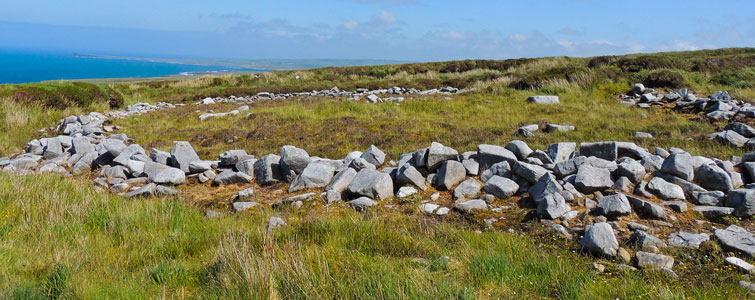The Ceíde Fields - Archaeology

The Ceíde Fields is an enclosed farmland divided into field systems by parallel dry stone walls.
The long strips of land are divided into rectangular fields which are regular and large ranging from 4 hectares to 10 acres.
Archaeologists think that the manner in which they are laid out was wanted: the fields were measured and created by men with a clear process of land division.
The over 1,5 km long dry stone walls were at least 1 m high ranging from 90 cm to 150 cm in width. They follow the contour of the Behy Valley and continue over the hill reaching a second field systems in the near Glenulra Valley.
There is clear evidence that this sort of systems can’t have been built by a small family group but involved the whole community; it is thought hundreds of workers took part in the project.
Only a community with a some rule of law and a high degree of social development could have done that.
We now know that they were a highly organised large peaceful community of dairy farmers who worked together on clearing hundreds of acres of forestry and dividing 1000 hectares of land into this farming system.
Their main economy was a dairying economy; the most of the fields were used as pasture land and the fields functioned as herd management, where milch cows, immature males and females and calves were separated into different fields.
The milch cows were in direct contact with farmers at least one a day for milking and bringing them to water from fields. That was the daily chore of the whole community.
Some smaller fields near the Visitor Centre suggest that the community grew cereal, probably emmer wheat, too. At Ceide Fields people lived in single family dwelling; 50-60 families (around 300 people) led a quiet life here.
It is thought that within the oval enclosure a round little house about six meter in diameter was built a few centuries before 3000BC and made from wood and other organic materials. The enclosing wall probably had served to exclude farm animals.
They were skilled craftspeople and builders in both wood and stone and had strong spiritual beliefs. They built also megalithic tombs scattered around this area.
The most interesting objects found are the stone cutting of a primitive plough, a saddle quern used for grinding the corn, a few arrowheads and some bits of pottery.
The bits of pottery give us information about who built Ceide Fields comparing them to other finds in Stone Age tombs and in Western Europe at this time.
They were part of a great community of early European farmers although it is not clear if they had French origin or arrived from East Europe spreading into Ireland and Britain and finally ended up at Ceide Fields.
As the land became wetter and less fertile and the bog started to grow, the population of Cede Fields had to move away in order to find new land to support themselves.
It was a slow decline over one or two centuries, in consequence the stone walls collapsed. They went only few miles down the road.
They settled in the low-lying land around Ballycaste and along Killala Bay.
They were witnesses of a slow changing environment beyond their control. The vast area of bogland started to grow forming a soft blanket from the cliffs to the hilltop.
When they settled they found a different vista and a warmer climate.
Pine, birch, hazel, oak, willow and alder grew at Ceide Fields. The trees provided firewood, materials for building, baskets, tool handles and food (hazelnuts).
It is thought the changing environment was caused by the human impact and by the weather on the Irish western coast.
The fertility of the soil deteriorated allowing the bog forming plants to spread easily, the removal of forest along with the rainy days (over 225 per annum) increased the amount of water in the soil.
The result was the formation of the bogland and the inevitable decline.
Detailed pollen analysis showed a dramatic drop in pollen of trees and a high increase in pollen of the typical bog’s grasses.







